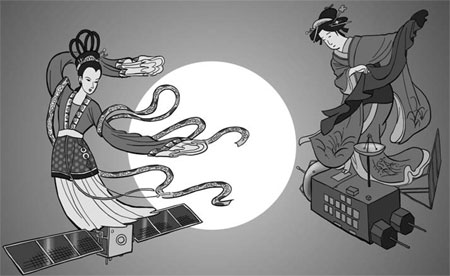China rocketing ahead in space program
Updated: 2007-11-01 07:21

China's space technology has progressed to a new phase with the launch of its first lunar orbiter Chang'e I on a Long March 3A carrier rocket.
In September, Japan launched the Kaguya lunar orbiter on a mission to observe the moon. Kaguya has already entered orbit around the moon. The main satellite and two sub-satellites, which separated from the main one, are in the final stage of preparation for their observation of the lunar surface and other missions.
Senior officials of the Japan Aerospace Exploration Agency (JAXA), which launched Kaguya, were invited by Chinese authorities to watch the launch of Chang'e I.
The 17th National Congress of the Communist Party of China has just ended. Publicizing the launching of Chang'e I at home and abroad is likely aimed at displaying the prestige of the Chinese government and the Party. When China launched the manned spacecraft Shenzhou-6 in 2005, Chinese officials also widely publicized the launch.
Successfully launching the lunar orbiter and the manned spacecraft on dates that were previously announced served to attract attention to Chinese technology.
China already has a high level of space technology. It has launched more than 100 Long March rockets since 1970, while Japan's H2-A rocket has been launched only 13 times.
The Japanese government's space technology staff and JAXA senior officials have long displayed a cool attitude toward China's space technology. Concerning the launching of Chang'e I, an internal document states: "The observational goal of Chang'e I is very similar to that of Kaguya, but Chang'e I is inferior in capability to Kaguya."
However, we have reservations about such an optimistic attitude on the part of the Japanese officials.
China's space development has drastically accelerated. Starting with the launch of the orbiter, China's lunar exploration program comprises a moon landing and deployment of a moon rover with the retrieval of lunar soil and stone samples. China also aims to advance its technologies for manned spacecraft.
Further, it is moving forward with projects to launch a reconnaissance satellite and another one for its own global positioning system.
In addition, China is launching communication satellites for Venezuela, Brazil and Nigeria, and also received an order from France to launch a communication satellite, showing the commercial success of its program.
China has voiced a strong desire to participate in the International Space Station (ISS) program in which Japan is involved and the United States and Russia play pivotal roles.
Some observers say that in the near future China will become one of the world's leading nations in the field of space development, equivalent to the United States and Russia.
In contrast, Japan's space program, despite its successful development of the H2-A rocket, lacks specific targets - including what type of satellite it will launch in the future - due to budget woes.
With expanding expenses regarding the ISS, there will not be much money to spare in Japan's space budget.
Some experts are voicing concern, saying Japan could face difficulties in maintaining technologies in the H2-A rocket, if nothing is done.
How will Japan move forward with space development? It will get left behind in the field of space exploration unless it plots solid strategies.
The Yomiuri Shimbun/The Asia News Network
(China Daily 11/01/2007 page11)
|
|
|
|
|
|